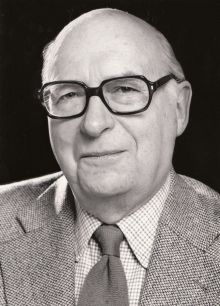Victor P. Whittaker facts for kids
Quick facts for kids
Victor P. Whittaker
|
|
|---|---|

Victor Percy Whittaker
|
|
| Born |
Victor Percy Whittaker
11 June 1919 Ainsdale, England
|
| Died | 5 July 2016 (aged 97) Cambridge, England
|
| Known for | Isolation of synaptosomes and synaptic vesicles and biochemistry of synaptic vesicles |
| Scientific career | |
| Fields | Neurobiochemistry and Cholinergic Transmission |
| Doctoral students | Thomas C. Südhof |
Victor Percy Whittaker (born June 11, 1919 – died July 5, 2016) was a brilliant British scientist. He was a biochemist, which means he studied the chemistry of living things. He was famous for being one of the first to study the tiny parts inside the brain. He figured out how to separate and study very small parts of brain cells called synaptosomes and synaptic vesicles. He also showed that these tiny vesicles store an important brain chemical called acetylcholine, which helps brain cells talk to each other.
Contents
About Victor Percy Whittaker
Victor P. Whittaker was born in Ainsdale, a town in England. He loved to learn about chemistry and biochemistry. He studied these subjects at Oxford University from 1937 to 1941. He earned his special doctorate degree, called a D. Phil, in 1945.
After his studies, he stayed at Oxford University. He worked as a teacher and researcher in biochemistry. From 1951 to 1955, he taught physiology at the University of Cincinnati in the United States.
Returning to England
In 1955, Victor Whittaker came back to England. He worked at a research institute in Babraham, Cambridge. He held important scientific roles there until 1966.
Then, in 1966, he moved to Cambridge University. He became a special professor of biochemistry and a fellow at Wolfson College. For a few years, he also worked as a chief research scientist in New York, USA. He was also a visiting professor at the City University of New York.
Later Career
From 1973 to 1987, Dr. Whittaker led the Department of Neurochemistry. This was at the Max Planck Institute for Biophysical Chemistry in Göttingen, Germany. Even after he officially retired, he kept doing research there. Later, he moved his research to the University of Mainz before returning to Cambridge. He passed away in Cambridge in July 2016, at the age of 97.
Amazing Brain Research
Victor Whittaker's journey into understanding how medicines affect the body began during World War II. He was part of a team that found a cure for arsenic poisoning. This cure, called dimercaprol, was the first time scientists had planned to create an antidote by studying how a poison works.
Discovering Synaptosomes
Later, he became a pioneer in using special cell study methods for the nervous system. In 1960, he made a big discovery. He found a way to gently break apart brain tissue. This process separated the ends of nerve cells, called presynaptic nerve terminals, from their main parts (axons).
He could then collect these separated nerve endings. He used a method called density gradient centrifugation to isolate them. He called these tiny, sealed nerve endings synaptosomes.
Why Synaptosomes Are Important
Synaptosomes became super useful for scientists. They allowed researchers to study how nerve cells work in a lab. Drug companies also used them to test new medicines. Thousands of scientific papers have been written based on studying synaptosomes. They helped us understand how signals are sent between nerve cells, a process called synaptic transmission.
Finding Synaptic Vesicles
Victor Whittaker didn't stop there. He then found a way to break open the synaptosomes. This allowed him to isolate even tinier parts called synaptic vesicles. These vesicles were very pure.
He proved that these vesicles store acetylcholine. This is a very important chemical that nerve cells use to communicate. This discovery helped explain how nerve cells release their chemical messages in tiny "packages." Scientists had thought that these small, clear bubbles seen under an electron microscope contained and released these chemical packages. Whittaker's work provided the proof.
Studying Electric Rays
To learn even more, he studied synaptic vesicles from a special animal. He used the electric organ of the ray called Torpedo. This organ is full of nerve cells that use acetylcholine.
Studying these rays helped him understand a lot about synaptic vesicle structure and how they work. He also learned that not all synaptic vesicles are exactly the same.

